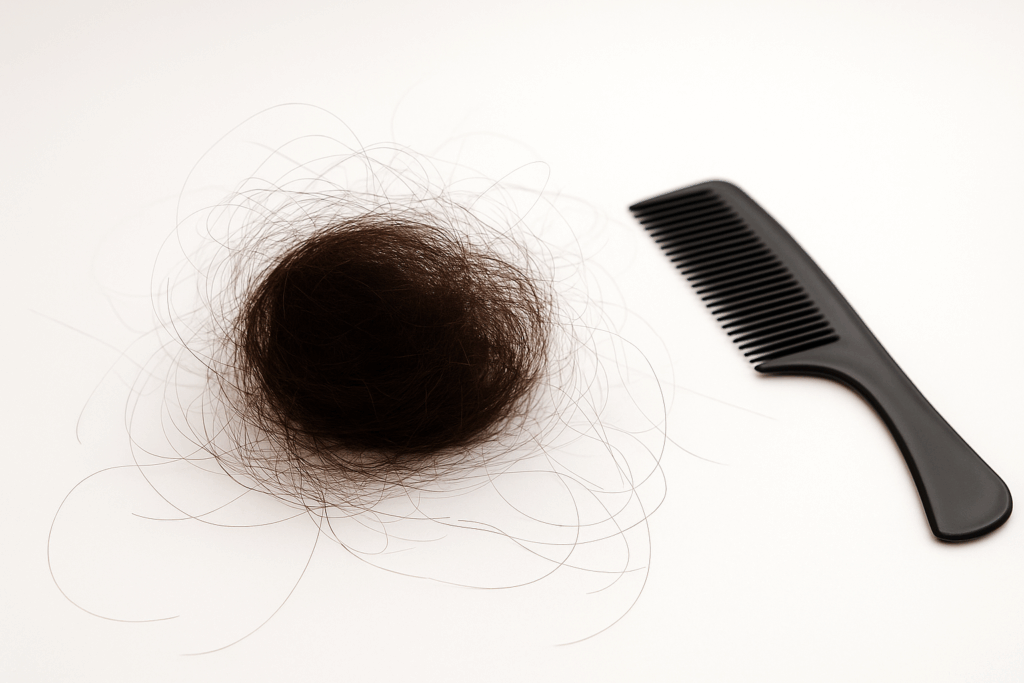Understanding Telogen Effluvium: Is Hair Loss Normal?

Sudden or diffuse hair loss is a shock for many sufferers. A common cause is telogen effluvium - a form of temporary hair loss that usually occurs after stress, illness or hormonal changes. But don't worry: in most cases, the hair grows back as soon as the triggers are treated.
In this article, you will find out what exactly is behind telogen effluvium, how it manifests itself and what options are available to stabilize hair growth again.
1. What is Telogen Effluvium?
1.1 Definition
Telogen effluvium is a form of diffuse hair loss. An excessive number of hairs enter the resting phase (telogen phase) of the hair cycle at the same time. This leads to the hair becoming evenly thinner.
1.2 Differentiation from other forms
In contrast to androgenetic alopecia (hereditary hair loss), telogen effluvium affects the entire scalp - not just individual areas such as the forehead, receding hairline or the back of the head.
2. Causes of Telogen Effluvium
2.1 Physical triggers
- Illnesses & infections: Severe infections such as the flu or Covid-19 as well as febrile illnesses can upset the hair cycle.
- Surgery & medication: Surgery, anesthesia or certain medications (e.g. beta blockers, antidepressants) are also considered possible risk factors.
2.2 Hormonal factors
- Pregnancy & childbirth: Many women notice increased hair loss after giving birth.
- Thyroid gland: Both hypothyroidism and hyperthyroidism can promote telogen effluvium.
2.3 Diet & lifestyle
- Nutrient deficiency: A deficiency of iron, zinc, vitamin D or biotin is one of the most common triggers.
- Stress: Permanent psychological stress affects the hormone balance and weakens the hair roots.
3. Telogen Effluvium – Symptoms and Diagnosis
3.1 Typical signs
Diffuse hair loss
A central feature of telogen effluvium is diffuse hair loss. This means that the hair falls out evenly over the entire head - in contrast to hereditary hair loss, which mainly occurs on the forehead, temples or back of the head. It is particularly noticeable that the hair appears thinner overall, with the top of the head often more affected than the sides. Many sufferers notice that the volume of their hair is reduced or that the scalp shows through more.
Sudden onset
Another typical feature of telogen effluvium is the delayed onset. The increased hair loss usually occurs 2-3 months after the triggering event - for example after an infection, surgery, pregnancy or a phase of severe stress. This temporal pattern is an important diagnostic criterion and distinguishes the disease from other forms of hair loss, which develop more continuously.
3.2 Telogen effluvium & medical diagnosis
Medical history & blood tests
A reliable diagnosis begins with a detailed medical history. The doctor asks the patient about possible triggers such as illnesses, medication, stressful situations or eating habits. This is followed by blood tests to identify possible nutrient deficiencies (e.g. iron, vitamin D, zinc, biotin) or hormonal imbalances. If necessary, a trichoscopy (microscopic examination of the scalp and hair roots) can also be carried out to reveal typical changes in the hair growth cycle.
Exclusion of other causes
An essential step in the diagnosis is the differentiation from other forms of hair loss. These include above all
- Androgenetic alopecia (hereditary hair loss), which usually occurs locally.
- Alopecia Areata (circular hair loss), which is characterized by round, bald patches.
This differentiation is crucial, as the treatment methods vary greatly depending on the cause.

4. Telogen Effluvium & Treatment Options
4.1 Acute measures
- Identify the trigger: The most important step is to find the cause (e.g. infection, stress, deficiency) and treat it specifically.
- Ensure nutrient supply: A balanced diet with sufficient vitamins and minerals or targeted supplements support hair growth.
4.2 Scalp & hair care
- Gentle care: Mild shampoos and gentle styling relieve the hair and scalp.
- Scalp massages: Regular massages (5-10 minutes daily) promote blood circulation and stimulate the hair follicles.
4.3 Long-term strategies
Professional care products:
Natural serums with biotin, caffeine or plant extracts can strengthen the scalp from the outside.
Stress management:
Relaxation techniques such as yoga, meditation or sport help to stabilize the hormone balance.
Conclusion: First understand telogen effluvium and then treat it specifically
Even if sudden, diffuse hair loss is worrying, telogen effluvium has a good prognosis in most cases. As soon as the cause is identified and treated, the hair usually grows back within a few months. With the right combination of a healthy diet, stress reduction and gentle care, hair growth can be stabilized in the long term. A high-quality hair serum can also support regeneration by strengthening the scalp and activating the follicles from the outside.
Laduti Hair Growth Serum can therefore provide meaningful support: With biotin, caffeine and many other high-quality plant extracts, it intensively nourishes the scalp and provides the hair roots with important nutrients. In combination with a healthy diet and a balanced lifestyle, the hair receives the best conditions to regain new strength.

FAQ
How long does telogen effluvium last?
As a rule, hair loss subsides after 3-6 months once the cause has been eliminated.
Can telogen effluvium be permanent?
No - in most cases it is temporary. If the hair loss persists for longer, another cause should be investigated.
What role does stress play in telogen effluvium?
Severe physical or emotional stress is a common trigger. Reducing stress can make a decisive contribution to recovery.
Which vitamins help with telogen effluvium?
Iron, zinc, vitamin D and other micronutrients are particularly important - it is best to take them under medical supervision.
What care supports regeneration?
Gentle scalp massages and serums with active ingredients such as caffeine, Procapil™ or AnaGain™ can promote blood circulation and strengthen the follicles.

